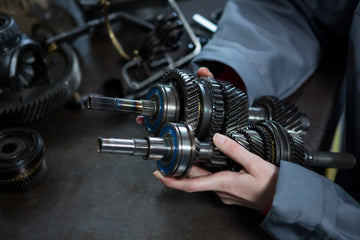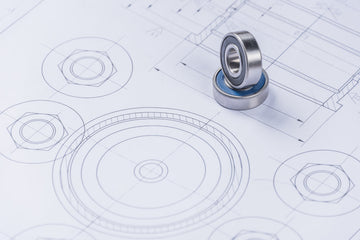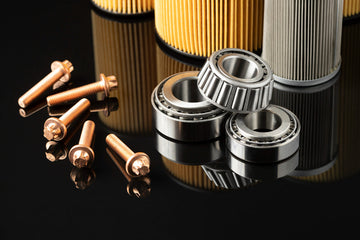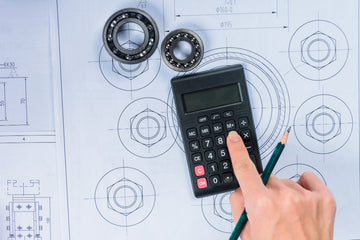Gearboxes are inherent mechanical parts of various systems used in diverse machines, both in a car and in a machine. A gearbox is mainly used to transfer mechanical input/output power among different components of a machine to adjust speed and torque to suit the application. Gearboxes have bearings which are important to the smooth running and the life cycle of the gearboxes. This paper shall discuss the various types of bearings applied in gearboxes, their purpose, significance and the effect they produce on the performance of the gearboxes. We will also explore more in-depth the usual problems associated with gearbox bearings such as noise, and the advantage of using the proper bearing in gearbox applications.
What Are Gearbox Bearings?
Gearbox bearings are basic ingredients, which aid smooth rotation of gears and shafts of a gearbox. These bearings reduce friction between moving components, and this tends to lessen wear and tear and makes sure that the gearbox operates optimally in the long run. Gearbox bearings come in many different types, which are used to accomplish specific tasks depending on the load and speed needs of the gearbox.
Gearboxes Common types of Bearings
Gearboxes usually have a variety of bearings to carry various load ranges, speed needs and work conditions. Examples of some of the most common bearings in gearboxes are listed below:
1. Ball Bearing Gearbox
Bearings in gearboxes are most likely to be ball bearings. They are made of balls suspended in two smooth races. These bearings are also identified by their capability to support radial and axial loads thus being suitable in a wide range of applications. The efficiency of ball bearings in gearboxes, durability, and their capacity to work at high speeds are the reasons why they are normally used. They are used to limit friction between rotating components of the gearbox and allow smooth and accurate operation.
The ball bearing gearbox is popular where speed is an important factor and the system must be as efficient as possible. Automobile gearboxes, industrial machines, and electric motors normally use the ball bearings.
2. Gearbox Thrust Bearing
A gearbox thrust bearing has been designed to deal with axial forces that are posed along the length of the shaft. These bearings are particularly applicable in gearboxes where there is plenty of axial pressure. Thrust bearings have a major role in providing the stability and unwanted movement prevention along the axis. They are also normally applied where high torques such as in car or factory gears require heavy loads to be handled.
There are various types of thrust bearings (e.g. ball thrust bearings and roller thrust bearings) which perform different load bearing functions and designs.
3. Roller Bearings in Gearbox
Another bearing used in gearboxes is in roller bearings. These bearings carry cylindrical rollers rather than balls making them to be capable of supporting a greater radial load. Roller bearings are used in heavy-duty applications, where high capacity of the load is a necessity. They can be applied to gearboxes where large forces and high torque must be conveyed at a minimum of friction.
Common types of roller bearings that are used in a gearbox include cylindrical roller bearings and tapered roller bearings, and each has its own benefits in dealing with loads and in terms of operational efficiency.
4. Needle Bearings
A special type of roller bearings employing long, narrow rollers is called needle bearings, or needle roller bearings. These are best suited to be used where there is a low space but heavy load-bearing capacity is needed. In compact gearboxes, needle bearings are often employed, with a benefit of being of small size and high efficiency.
How Bearings Contribute to Gearbox Performance
The kind and quality of bearings used determines to a large extent the performance of a gearbox. The function of bearings is to minimize friction; this minimizes wear and tear on the elements of the gearbox. Along with this, they assist in keeping the gears in an accurate direction, so that the functioning is smooth without unnecessary noises and vibrations.
Reducing Friction and Wear
Bearings minimize friction between parts in motion to make sure that the gearbox is working effectively and that minimum energy loss is experienced. This is converted into an increase in fuel economy of automotive gearboxes, greater machinery performance and the increase of the life of the gearbox components. The less the gears and shafts are worn and torn, the smoother the operation and hence the lower costs of maintaining them.
Speed and Torque Maintained
Gearboxes are also supported by bearings that ensure the preferred speed and torque production of the system. To illustrate, a gearbox consists of ball bearings that are used to ensure that high speed rotations are supported by minimizing friction. In the meantime, roller bearings such as those in heavy-duty industrial gearboxes can support higher torque levels with no efficiency loss.
Reducing Gearbox Bearing Noise
Bearing noise is one of the greatest problems in gearboxes. The noise of gearbox bearings may occur because of different causes, such as inappropriate lubrication, misalignment, and the utilization of low-quality bearings. A common indicator of friction between the bearing surfaces is noise, and this may cause premature failure. High-quality bearings, proper lubrication, and maintenance of the gearbox are necessary to minimise the noise caused by the gearboxes bearings.
Choosing the Right Bearing for Gearbox Applications
The choice of the appropriate bearing when using a gearbox is paramount to the goal of having an optimal gearbox. Depending on the load capacity, speed, and environment in which the gearbox is used, the right choice is determined. The following are hints on how to choose an appropriate bearing:
- Load Handling: Various bearings are made to suit various kinds of loads. Ball bearings suit lighter loads better and roller bearings are more applicable in heavy use.
- Speed Requirements: Ball bearings are generally preferred when the gearbox requires high speed since it has low friction and can affront rotating velocity.
- Environment: Depending on the environment, the bearings must be chosen. E.g. in case of high temperatures or aggressive chemicals reached the gearbox, bearing of high temperatures or avoidance of a corrosive environment might be required.
Typical Gearbox Bearing Problems
Although gearbox bearings are necessary to operate smoothly, they may occasionally cause an issue with time. The most widespread problems are:
1. Wear and Tear
Bearing in gearboxes can be worn out with time as a result of constant using. This results in higher friction, lower performance and even gearbox breakdown. Maintenance and use of high quality bearings are able to enhance the life of the gearbox.
2. Lubrication Problems
Gearbox bearings should be well lubricated to ensure that their performance is efficient. A shortage of lubrication or the wrong kind of lubricant can lead to overheating of the bearings which would lead to early failure.
3. Misalignment
When the components of the gearbox are misaligned, it would stress the bearings, which will wear excessively and generate noise. The alignment should be right during installation and frequent maintenance.
Gearbox Applications Popular Bearings
Among the most popular bearings in gearbox applications is:
- 600 Bearing: The 600 bearing is common in numerous applications in mechanical use, and is perfect in light-load gearboxes.
- 607-2RS Bearing: Sealed bearing offering greater resistance to dust and other contaminants, which makes it acceptable in harsh gearboxes.
- 608-2RS Bearing: It is a universal bearing which is mostly applied in mini-gearboxes when space is a major constraint.
- 626-2RS Bearing: It is also sealed bearing which is applied in those applications wherein space and load handling are extremely serious.
- 627-2RS Bearing: The Bearing is ideal because of quiet operation and long life, which is applicable in smaller gearboxes.
- 629-2RS Bearing: 629-2RS bearing is employed in small machineries and gearboxes with high performance in confined areas.
The Significance of Quality Bearings in Gearbox Applications
Bearings are fundamental parts of a gearbox operation that guarantee it works smoothly, generates lower friction, and is more efficient. The kind of bearing applied in the gearbox is based on the consideration of such factors as load manipulation, speed demand, and environment that it will operate. It can be ball bearings, thrust bearings or roller bearings, but the right selection will improve the work of the gearbox and its working life.
Regular maintenance and high quality bearings are essential in ensuring that such problems as noise in the gearbox bearing and premature wear are kept at a minimum. In choosing bearings to use in gearboxes, the most important factor to take into consideration is the nature of the machine in question and the availability of the best bearings that would be most efficient and also durable.
Bearmax USA is a reliable vendor that provides quality bearings and gear solutions to the unique requirements of your gearbox utilization.




